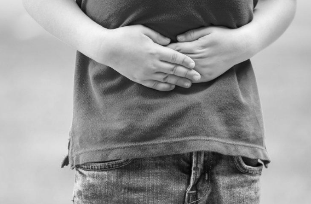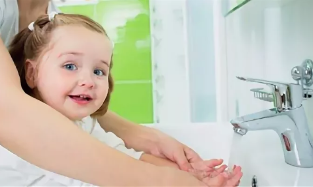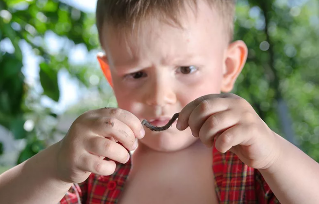Infestations elmintiche in the pediatric age – one of the most common and underestimate the risk of disease. Helminths, children not only cause insufficient intake of nutrients in the body, but become the cause of allergic reactions, chronic intoxications, reduction of the immune system, diseases and injuries of the gastrointestinal tract. Signs of parasitosis develop not once, for a long time, the disease can be asymptomatic or unexpressed clinical picture and determined only in the laboratory.

The prevalence of species of helminths
It is believed that helminthiasis, infestation by worms is a disease, more related to people of social class is lower than average, live in unsanitary conditions, often in contact with infected animals or soil. However, according to statistics, only in the european countries helminths found during the examination, each third patient.
In nature, there are more than 300 species of helminths, more than 70 kinds popular in Russia, the other can penetrate the human body while traveling in exotic countries. Among all the types of worm parasites, capable of existing in the human body, divided into three groups:
- nematodes belonging to round helminths, some of the most common parasites in children (pinworm, trichuris trichuris, trichinella, ascaris);
- the tape (plan) in worms, related to the cestode (various types of tapeworms, tapeworms and Echinococcus);
- parasites flukes or flukes, became of opistorhoza, fascioliasis, chistosos, paragonimoza, etc.
In most cases the helminth parasites and multiply in the intestine, however, the eggs and the larvae can be recorded with the blood circulation to various organs of the body. Often suffer from the nearby organs of the gastrointestinal tract: the liver, the gall bladder, however, the parasites can colonize muscle tissue, the lungs, the brain.

Bot: routes of infection
Ways to infect the worms depend on the characteristics of their development cycle. For some groups of helminths man is the "master", in the body of the which they live and breed, for others, an intermediary. In some cases, parasites necessary for the maturation of eggs in the soil or other conditions. But the fundamental rule for the protection from contamination is the hygiene, the fact that in childhood are not always.
For children of the age – the period in which it is constant, the immunity is not yet formed, which greatly increases the likelihood of infection and parasitosis. The desire to taste all the flavor, the more contact with the ground, the sand, all of the objects increase the penetration probability of eggs of worms in the body of the child.
The most common helminth – ossiuri and roundworms – carry forward to dirty hands, they can remain in objects for the home (door handles), to penetrate inside of the body with the food (poorly washed the berries, herbs, vegetables). In addition, there is the likelihood of the spread of helminths in contact with an infected person or animal, or the existence in the immediate vicinity with them.
Ossiuri are of the worms, causing reinvasion: itching, causing the females ossiuri in the process of laying eggs outside of the anus, forcing the patient to touch, to rub, to scratch the irritated surface and distribute the eggs of the parasites on the underwear, underwear, clothing, objects, and surfaces. When you ingestion of eggs, which remain on the hands or on the bed, occurs reinvasion, auto-infection of the patient. Initial infection the children when this occurs more often in kindergartens, in schools, in offices, in crowded places of the children.
What are the factors that increase the risk of infection helminths?
- The non-respect of the hygiene of the hands: the passage to wash his hands after returning from the road, guests of the toilet, before every meal.
- The habit of biting your nails, sucking your toes, keep in the mouth various objects (pencils, pens, toys, etc).
- The presence of pets, attend the road: even if timely anthelmintic treatment of dogs and cats, it can distribute the eggs of the worm, taken away on the hind feet, wool.
- Failure to comply with the rules for the treatment of vegetables, fruits, berries, and vegetables before consumption.
- Low level of hygiene in the home: wear shoes, not washing the floors, etc.,

The worms in children: variety of symptoms and treatment of helminth
Many types of parasites for a long time do not contribute to the formation of an explicit clinical picture delete: the target parasite – exist as well, for not to be noticed as the host-vector. Therefore, bright symptoms helminthiasis you can see, only in cases, when the infection (multiple in origin, or due to the long period of the hidden), and/or the child has a lowered immune system, there are concurrent diseases, on the background of which bot is more clearly manifested. A situation – the infection species of exotic parasites, causing a strong reaction of the body.
Signs common helminths in children:
- increase in appetite without increase in weight;
- excessive production of saliva;
- manifestations of dyspepsia intestinal, flatulence, stool, tippy, nausea, pain in the area of the stomach, right hypochondrium, intestinal cramps;
- dizziness, headaches, fatigue;
- the tendency to allergic reactions, which have not been previously observed, or more manifestations of acute allergies;
- sensitivity, irritability, sleep disorders, of attention, of memory associated with intoxication of the waste products helminths;
- the fragility, hair loss, bassoon nails with the development of beri-beri and the lack of iron;
- frequent inflammatory processes of the nasopharynx (sinusitis, sinusitis, pharyngitis, etc), the genitals, especially the girls because of the anatomical proximity of the vagina and anus.
The case of long periods of helminthoses in children, there is a delay in bands of standards in the growth, weight, development, operating disorders and diseases of the gastrointestinal tract, the symptoms of severe intoxication, anemia, allergies, frequent respiratory illnesses, bacterial and viral etiology, neurological deficits.
The first symptoms usually appear after 2-4 weeks after ingestion of eggs of worms in the body. They vary depending on the number of parasites, the level of protection of the forces and of the state of health of the child, but also for species of helminths. So, ossiuri cause night itching in the area of the anus, which promotes sleep disorders. When toxocarosis distinctive signs are cough without signs of respiratory disease, fever, attacks of asthma and allergic reactions.
The widespread belief that bruxism, scraping of teeth in a dream – a sign of the presence of worms in the body, they will tell you medical scientists. The phenomenon of bruxism is associated with the characteristics of the human nervous system. Even if the helminths, especially ossiuri can disrupt sleep and promote the neurosis of a child, bruxism is not a confirmation pest infestations. The treatment of this phenomenon deal with neurologists and dentists.
The case of long periods of helminthoses all the people with the evolution of the clinical picture of intoxication of the organism.

Diagnosis of helminth
In most cases helminthiasis in children diagnosed through annual budgets, surveys of cala on worm eggs. However, this is not the most reliable way: in the presence of symptoms and negative analysis, you need to remember that not all types of worms that can be defined in this way. Those species that lay eggs, they can also avoid detection by laboratory tests, as well as the rate of playback may not coincide with the analysis time. Are also known the cases, when in the body, are found one or more specimens of the same sex, are not capable of reproducing, but harmful to the whole life cycle.
When the negative analysis cala recommends that you perform the search again in 2-3 weeks. In the list of the estimates of the research include analysis for the presence of worm eggs and scraping on enterobiasis. Suspect the presence of helminths is also possible via the results of blood analysis: a high level of eosinophils in combination with a decrease in hemoglobin in most cases, this means the presence of parasites in the body.
To clarify the diagnosis can be applied to biological research phlegm, bile, urine, coprogram faecal masses.
To clarify the diagnosis of suspected echinococcus explore the organs of the peritoneum, ultrasound and/or method of the x-ray. Opisthorchiasis diagnosed by analysis of the intestinal contents and intubation duodenal remote sensing.
To clarify the type of parasite and the damage to the body help the immunological research. After an accurate diagnosis, select a treatment method.
Drugs methods of treatment of helminths in children
Therapy helminthoses is based on two directions: the liberation from the parasites and detoxification of the body, the reduction or leveling damage helminths.
To reduce the severity of signs of poisoning are assigned the vitamins (A, C), iron, vitamins and minerals, a glucose solution, the rate of infusion gemodeza, etc. In some cases, demonstrates the use of diuretics, and antihistamines. With the defeat of the heart muscle, the liver tissue can be applied hormonal funds.
As maintenance therapy prescribed chelators, putting out from the blood the waste products of the parasites, the enzymes that contribute to the improvement of the digestive processes and the functioning of the organs, etc.,
In each helminthoses is not very recommended the use of drugs of a wide action in children. Medicines that cause the death of the parasites affect the human body, therefore, the choice of a medication and its dosage must be handled with care.
Animals and traditional methods to get rid of worms categorically are not recommended due to lack of evidence and the possibility of measuring with precision the dosage, and the likely impact on the body of a child.
The principles of therapy in the helminthoses
In most cases, the therapy of helminthiasis, a member of the family of treatment it is necessary to make all the residents on the territory of adults and children. This not only applies to highly contagious askaridoza, but also to other types of helminths. Medicines for every member of the family, also collects the doctor depending on the age and state of health.
If in the house there are pets, they necessarily spend an anthelmintic treatment, regardless of the time, after the prevention.
In the house, where he lives with a sick child, you will need to do daily hygienic cleaning, preferably at the time of treatment to remove all the carpets, soft toys, blankets. Bed linen and underwear, towels, personal change as often as you can (slip – twice a day), after the washing of all linen must be carefully ironed.

You need to respect the rules of hygiene: wash your hands after every visit to the bathroom, coming back from the road, use only personal towels, concisely, hair and nails. Without respect for the rules of therapy may be ineffective because of the constant presence of sources of contamination in the environment of the patient.
Prevention of infection by worms
The preventive measures in the first place refer to the rules of personal hygiene. Often the worm eggs are transferred into the oral cavity with the hands, and the washing of the hands helps to prevent the most cases of infection.
Other preventive measures in the same way you refer to:
- the careful (not less than 2-3 minutes under the running water) to wash the berries, vegetables, green leafy vegetables before a meal, if you plan to use raw;
- a long heat treatment of river fish (40-60 minutes) prior to consumption;
- timely preventive anthelmintic therapy in domestic animals;
- general cleaning of the house in accordance with the hygiene.



































